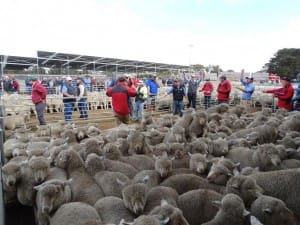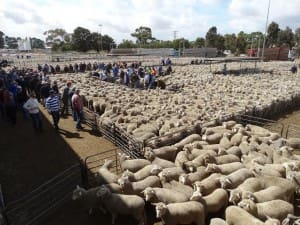
Elders Aaron Pascoe and the red team sell lambs in the recod Hamilton yarding. Picture: Tracey Kruger.
HAMILTON has set a new Australian saleyard record for the most lambs offered, yarding 58,631 lambs on Wednesday, 4578 more than the previous week’s daily yarding.
Meat and Livestock Australia’s market information manager Ben Thomas confirmed that the south-west Victorian saleyard has yarded the biggest number of lambs in Australia again, a record it has held for about 13 years.
“It is well and truly the largest lamb-selling centre in Australia.”
The previous record was also held by Hamilton – 57,097 lambs on December 9, 2009. Since the first MLA records in 1998, Hamilton has consistently yarded more than 48,161 (December 2010) around this time of the year, holding the top 20 yardings, except for the 50,279 lambs yarded at Ballarat on December 13, 2011.
Saleyards at Wagga Wagga in New South Wales hold the Australian record for the most sheep and lambs yarded; at 72,000 on November 9, 2006. On December 13, 2000, Hamilton agents yarded 70,420 sheep and lambs, before the centre started separate sheep and lamb sales.
Prices hold up despite lamb supply pressure
Despite the huge Hamilton yarding, MLA’s National Livestock Reporting Service reported prices for medium trade weight lambs as firm to up to $2 dearer. The largest gathering of processors was present, along with many more restockers, and bidding remained steady in a slightly weaker sale, the NLRS said.
Light trade weights were also firm to $2-$3 dearer compared to Hamilton’s lamb sale on Monday this week when 25,563 lambs were offered. Light 2 and 3 score trade weight lambs made from $90-$103, to average around 515c/kg cwt. Medium trade weight 3 scores sold from $114-$128 and heavier 3 to 4 score lambs made $126-$140, or 495-546c/kg, averaging an estimated 520c/kg. Heavier trade weight lambs were $3-$4 cheaper, with plainer drier skinned lambs making up to $7 less, the NLRS said.
The better quality heavy lambs sold equal to $2-$3 cheaper. Heavy 4 score lambs sold from $141-$149 and extra heavy 4 and 5 scores made $143-$175 to average close to 510c/kg.
Restockers from Victoria’s west, north, Murray and Wimmera districts, and South Australian border buyers, paid $48-$78 for the very light lambs and $89-$104 for 2 and 3 score 10-19kg cwt lambs. Very light lambs averaged 570c/kg and light weight store lambs 2 scores 530c/kg. Light 2 score lambs sold from $74-$89.
Mr Thomas said the consistency of the trade lamb indicator this year reflected the strength of domestic and export demand, assisted by less New Zealand production and the lower A-US dollar exchange rate.
“Rather than be 200 cents from the top to the bottom it has really only been 100 cents.”
Hamilton seasonal peak reached
JM Ellis and Co auctioneer Robert Pike agreed with Hamilton saleyard manager Chris Dahlenburg that Hamilton has now had its peak seasonal 2015 lamb yardings.
Mr Pike said the higher seasonal peak is a few weeks earlier due mostly to the dry season.
“I’m pretty sure it is the peak.
“I reckon next week it might come back to the high 40s and then it will just drop away from there,” he said.
“There will be a lot of lambs sold pre-Christmas and there will be next to nothing after Christmas.”
Mr Pike said “top-end” prices were holding their ground and there were still plenty of restockers trying to buy store lambs.
“The same thing happened last year – a lot of the lambs are better than I thought and secondly, there has been plenty of blokes put their hand up trying to buy stores which has put a floor in the market,” he said.
“I reckon our numbers of shorn lambs are probably going to be limited this year because blokes who normally put green crop in for their seconds have found their crop hasn’t been very successful in a lot of cases.
“Secondly, with store lambs making $85-$100 and no green crop, they’ve taken the money running.”
Source: MLA, NLRS, JM Ellis and Co.


HAVE YOUR SAY